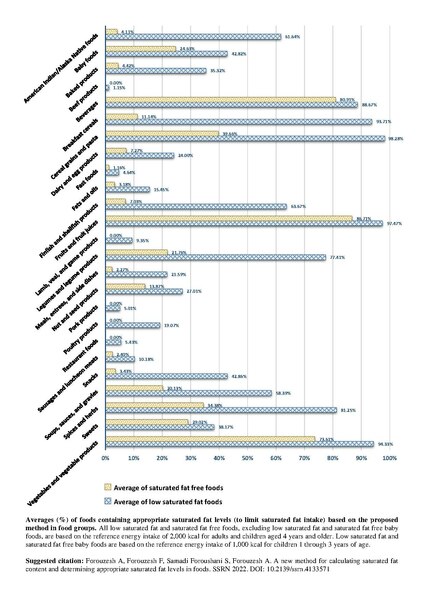File:Averages (%) of foods containing appropriate saturated fat levels (to limit saturated fat intake) based on the proposed method in food groups.pdf

Original file (1,239 × 1,752 pixels, file size: 354 KB, MIME type: application/pdf)
Captions
Captions
Summary[edit]
| DescriptionAverages (%) of foods containing appropriate saturated fat levels (to limit saturated fat intake) based on the proposed method in food groups.pdf |
English: Averages (%) of foods containing appropriate saturated fat levels (to limit saturated fat intake) based on the proposed method in food groups. All low saturated fat and saturated fat free foods, excluding low saturated fat and saturated fat free baby foods, are based on the reference energy intake of 2,000 kcal for adults and children aged 4 years and older. Low saturated fat and saturated fat free baby foods are based on the reference energy intake of 1,000 kcal for children 1 through 3 years of age. About 95% of foods contained saturated fat. On the basis of the proposed method, the averages (%) of saturated fat free and low saturated fat foods in food groups were 18.84% and 44.67%, respectively. Cereal grains and pasta with 98.28%, fruits and fruit juices with 97.47%, vegetables and vegetable products with 94.33%, breakfast cereals with 93.71%, beverages with 88.67%, spices and herbs with 81.25%, legumes and legume products with 77.41%, and finfish and shellfish products with 63.67% had the highest averages (%) of low saturated fat foods. In contrast, beef products with 1.15%, fast foods with 4.64%, pork products with 5.01%, restaurant foods with 5.43%, lamb, veal, and game products with 9.35%, sausages and luncheon meats with 10.18%, fats and oils with 15.45%, and poultry products with 19.07% had the lowest averages (%) of low saturated fat foods. In general, fats and oils (in the form of pure fats and oils or foods containing fat or oil), meats (such as beef, veal, lamb, mutton, pork, poultry, finfish, shellfish, and meat from other species), and egg yolks contained saturated fat. However, the saturated fat content in them was different. |
| Date | |
| Source | Own work |
| Author | SSamadi15 |
Licensing[edit]
- You are free:
- to share – to copy, distribute and transmit the work
- to remix – to adapt the work
- Under the following conditions:
- attribution – You must give appropriate credit, provide a link to the license, and indicate if changes were made. You may do so in any reasonable manner, but not in any way that suggests the licensor endorses you or your use.
- share alike – If you remix, transform, or build upon the material, you must distribute your contributions under the same or compatible license as the original.
File history
Click on a date/time to view the file as it appeared at that time.
| Date/Time | Thumbnail | Dimensions | User | Comment | |
|---|---|---|---|---|---|
| current | 18:56, 19 October 2023 |  | 1,239 × 1,752 (354 KB) | SSamadi15 (talk | contribs) | Uploaded own work with UploadWizard |
You cannot overwrite this file.
File usage on Commons
There are no pages that use this file.
Metadata
This file contains additional information such as Exif metadata which may have been added by the digital camera, scanner, or software program used to create or digitize it. If the file has been modified from its original state, some details such as the timestamp may not fully reflect those of the original file. The timestamp is only as accurate as the clock in the camera, and it may be completely wrong.
| Author | Sadegh Samadi |
|---|---|
| Software used | Microsoft® Word LTSC |
| Date and time of digitizing | 22:42, 25 May 2023 |
| File change date and time | 22:42, 25 May 2023 |
| Conversion program | Microsoft® Word LTSC |
| Encrypted | no |
| Page size | 595.32 x 841.92 pts (A4) |
| Version of PDF format | 1.7 |